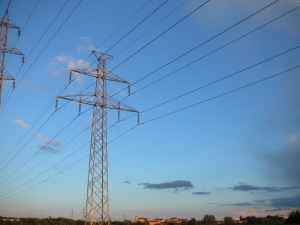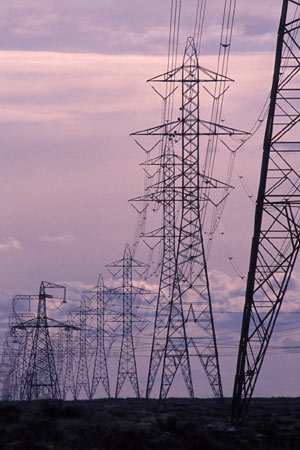$1.3 Billion in Transmission coming soon near you!
June 10th, 2006

Yes, they’ve made it very, very official, and I hope everyone who is experiencing a tightening and lurching stomach at the prospect of this $1.3 BILLION transmission project (Phase I of how many phases?) calls or emails Bill Grant of the Izaak Walton League (651) 649-1446, and George Crocker, North American Water Office, (651) 770-3861, to thank them for ushering through the 2005 Transmission Omnibus Bill from Hell. Special thanks are due Rep. Aaron Peterson too, email him or call him at (320) 226-1737. This is the direct result of that bill, this is a direct result of their “deal, a package deal, a good deal.” Here’s that deal, SF1368/Ch97. This bill made these projects possible.
It makes me sick…
Here’s the STrib’s report:
Electricity network upgrade underway
Xcel Energy and other utilities kicked off a $1.3 billion project to add transmission capacity in Minnesota and neighboring states.
Joy Powell, Star Tribune
Regional utilities on Friday filed regulatory papers kicking off a $1.3 billion transmission project aimed at feeding the region’s growing appetite for electricity.
Between 2009 and 2020, Xcel Energy Inc. and other utilities will upgrade a transmission “backbone” in Minnesota and neighboring states.
It’s the biggest such effort undertaken by Xcel and other Midwest utilities in nearly 25 years, said Terry Grove of Great River Energy, a project leader.
“These transmission capacity upgrades are needed to deliver new electricity generation to support economic, job and population growth in the future,” Grove said, adding that they’re also needed to deliver more wind energy.
Customer demand for electricity is projected to grow by 6,300 megawatts from 2009 to 2020, or about 2.5 percent a year. (One megawatt can serve about 1,000 households.)
“It’s existing customers using more energy,” Grove said. “It’s new customers, and that’s generally a measure of the economic growth and vitality of the state. And in some cases, you’ve got industries that are expanding dramatically, like the ethanol industry and, potentially, biodiesel refineries.”
With more capacity in the transmission system, utilities will be better able to buy competitively priced wholesale energy supplies and move it through the system.
And that could help lower customers’ bills overall, officials said.
“We are definitely operating with the lines at their full capacity many times,” Grove said.
The approximate lengths and locations of the proposed lines:
â?¢ A 200-mile, 345-kilovolt line between Brookings, S.D., and the southeastern Twin Cities. Also, a related 30-mile line.
â?¢ A 200-mile, 345-kilovolt line between Fargo, N.D., and the St. Cloud-Monticello area.
â?¢ A 150-mile, 345-kilovolt line from the southeastern Twin Cities area to Rochester and La Crosse, Wis.
â?¢ A 70-mile, 230-kilovolt line in the Bemidji area of north-central Minnesota.
Once the Minnesota Public Utility Commission approves the plans, Xcel will mail letters to potentially affected property owners along each of the planned paths of the transmission lines, letting them know how they can learn more, said Laura McCarten of Xcel.
That route-permitting process will determine the paths of the power lines, the location of substations and which owners will be affected. The utilities could seek condemnation of land needed for public use, if agreements can’t be reached.
“We know that we will cross many parcels, but it’s very hard to quantify at this point,” Grove said.
“We’re very early in the process. The filings we just made [Friday] are to seek the Public Utilities Commission’s approval [of] how we will notify local government units, landowners and the general public.”
Xcel Energy, Great River Energy and Otter Tail Power Co. will cover much of the $1.3 billion cost, which will be passed on to consumers in small amounts, beginning in 2009 or 2010.
By 2012, or once the projects go into service, the investment could result in an increase of less than $1.50 per month to a typical residential customer’s bill by 2012, Xcel spokeswoman Mary Sandok said.
This $1.3 billion project is the first of three phases. The second will build more transmission lines and substations to serve the load primarily in eastern Minnesota.
The third will create more facilities to integrate new generation into the grid, Grove said.

Leave a Reply